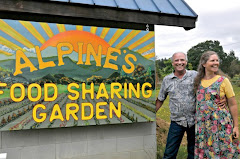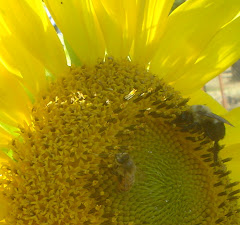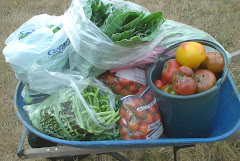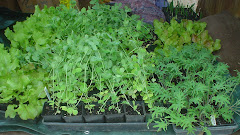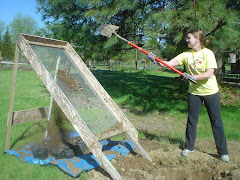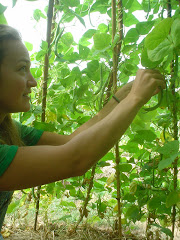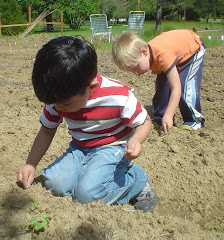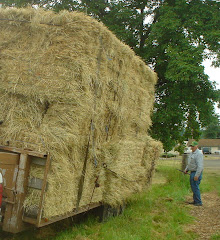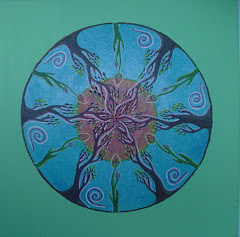 |
| Llyn, with a variety of bean seeds |
In the
Sharing Gardens we probably save about
80 - 90% of our own seeds. It really isn't that difficult to do and it
is very gratifying to experience this deeper level of "local food
self-reliance". If you have a garden plot that is separated from other
gardens by at least 500 feet (to prevent unwanted cross-pollination) you
can save your own seed. Even if there are other gardens nearby, there
are many crops you can grow that will
not cross (tomatoes, beans and onions, for example) so don't let that stop you.
There are many good reasons to save your own seed:
- It will be more adapted to your local growing-conditions
- You can "select" for certain qualities/characteristics (early ripening, sweetness, cold-tolerance etc)
- The flowering plants provide food for pollinators
- You have better control over the quality of your seed
- You are not as dependent on supplies being available from outside sources
- It's fun!
 |
| Chris, winnowing lettuce-seed. |
Always start with Heirloom (or "open-pollinated") seed.
"Hybrid" seed is developed in a carefully controlled environment that
crosses unique qualities between parent-plants to yield consistent,
specific results (like early-ripening "Early Girl" tomatoes). If you
save seed from a hybrid plant, it is likely that it will revert back to
one, or the other's parent-qualities and not give you the desired
outcome. Many seed-companies will label their packets, or inform you in
their catalog descriptions so you know what you are starting with; or
you can do an on-line search and have your "shopping list" handy next
time you pick out seeds, or starts. Of course, once you start saving
your own, you always know you've got "heirloom" seed.
Some plants easily cross-pollinate with other plants of the
same family (see below)
. It is difficult to control the outcome of these crosses and, you won't know the results until you grow out the seed
the following year.
For example, many gardeners have had the experience of having a squash
seed germinate in their compost pile, grow to gigantic proportions and
discover at harvest time that their "zucchini" is funny shaped, or has a
woody skin or poor flavor. These variations are due to
cross-pollination.
Peppers also cross easily so, if you grow hot- and sweet-peppers close
to each other, the seed you save may either have "sweetened" your hot
peppers, or "heated" up the sweet.
Sometimes these crosses are beneficial, creating a variety that is an
improvement over either of its "parents" but beneficial "crosses" are
rare. Often (unless you know what you're doing) you'll end up with
something that isn't quite as good as either of its parents.
 |
| Squash-blossom with bees. |
Examples of plants that easily cross-pollinate:
- Squash - with other squashes (some varieties won't cross with each other but for specifics, do more research HERE)
- Cucumbers - with other varieties of cukes
- Melons - with other varieties of melons
- Peppers - with other peppers
- Lettuce - with other lettuce
- Broccoli/Cabbage/Kale/Cauliflower - with each other
- Chard/Beets - with each other
If you wish to save seed from the plants listed above you either need to
learn which varieties cross and keep them far away from each other when
they're going to seed, or grow them on alternate years.
Some plants won't easily cross,
even with other plants in the same family. Tomatoes are a good example:
you can grow two, five or ten varieties in close proximity with each
other and the seed you save will
almost always have the same
characteristics as the plant you picked it from. On rare occasions we've
had tomatoes that were a 'cross' from two varieties of plants we grew
the year before. (Though we haven't experienced it ourselves, we've
heard that 'potato-leaf' varieties such as
Stupice or
Brandywine are especially susceptible to crossing.)
 |
| Brandywine Heirloom tomatoes |
Examples of plants that won't easily cross-pollinate:
- Tomatoes
- Beans
- Peas
- Onion family (includes garlic, shallots, leeks)
Can my garden seed cross with "weed" seed?
Yes! There are wild relatives of domestic vegetables that, if flowering
at the same time, can 'cross' making your seed produce fruit that is
woody, or bitter or has other undesirable characteristics. Learn to
identify your local weeds (especially if there are big, open fields of
them nearby). Consult expert sources to learn of techniques to avoid
this problem (i.e. hand pollinating, bagging the flowers, timing your
bloom to avoid the wild varieties' blooming. etc). Examples: Wild
lettuce can cross with domestic lettuce; Queen Anne's Lace is a wild
variety of carrot.
 |
| Dustin saving sunflower seed |
Can I "save seed" from produce I buy from the store? Sometimes, but not always. Tomatoes are often hybridized (and being "organic" does
not
mean they grew it from heirloom-seed). Melons are often from hybrid
seed, and they may have been grown in a field next to other melons that
they could have crossed with (true with squash as well). On the other
hand, we have gotten excellent bean seeds at the bulk-food section of
the grocery, and grown fantastic sunflowers from bulk-seed (raw and
unsalted, and still in the shell -- of course.) See the article below,
if you want to grow potatoes from grocery-store "seed".
This
post just covers some of the most basic aspects of seed-saving. For
more detailed info, read our posts below and/or consult other sources
through books or the internet.
Please leave us comments about your own experiences of saving seed below. It's great when we can all learn from each other!
Here are several posts we've written that include information on saving seed: (click on the bolded text.)
Tomato Seeds:
Tomatoes are a good plant to start with if you're learning to save
seed. As long as you know that the plant you're saving from is not
hybrid (see above) you are bound to be successful!
Lettuce: Just be sure you save seed from
only one variety
of lettuce at a time (it crosses easily if plants are closer than
50-feet apart). With one plant you can save enough seed to keep you, and
your whole neighborhood (!) supplied with seed for several seasons to
come.
Peas:
are easy (if you can restrain yourself from picking every last ripe
pea-pod <smile>). Be sure to follow the instructions in the post
and, once the seed is fully ripened and dry, freeze the seed to prevent
pea-weevil larvae from ruining your batch.
Scarlet Runner Beans: Beautiful red blossoms, big seeds (easy to harvest and dry) and the most delicious bean we know of...what's not to like!
Potatoes:
If you're already growing potatoes, saving seed is as simple as sorting
out the smaller egg-sized ones and storing them till next season. You
can also find seed-potatoes in the organic section of your grocer's in
the spring.
Saving your own seed is only one of the many benefits of a sharing-type garden (one big garden, instead of many separate plots). To read about how a sharing garden works, and many of its other benefits,
CLICK HERE- Overview of the Sharing Gardens).
(
BENEFITS of a Sharing Garden).
 |
| Ismael trimming dill seed-heads; lettuce going to seed in lower-left corner. |





















